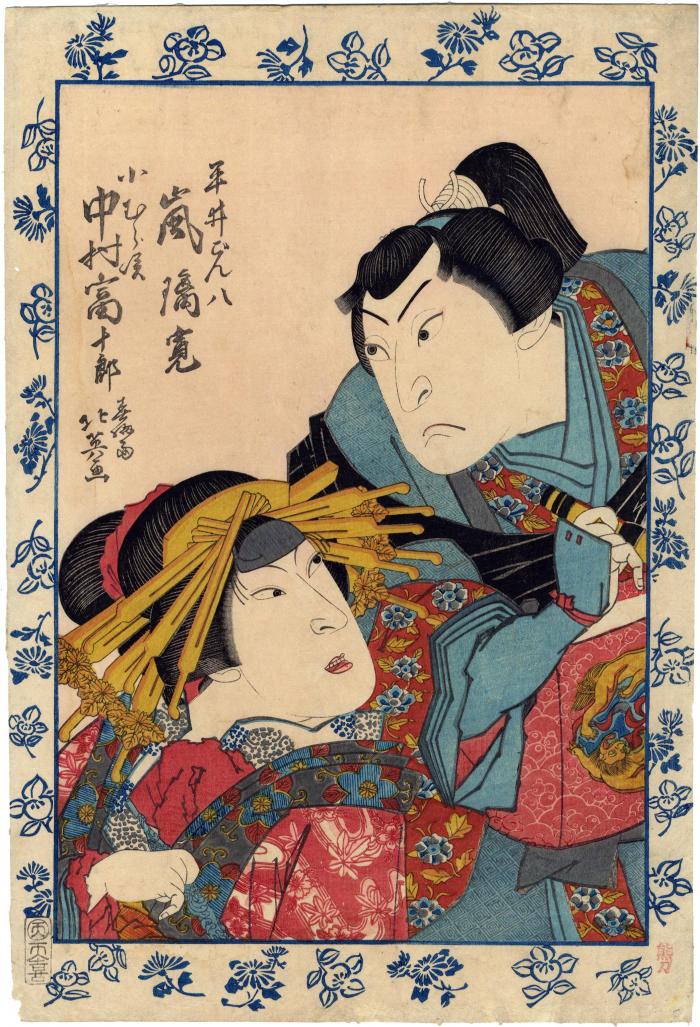Shunbaisai Hokuei (春梅斎北英) (artist )
Arashi Rikan II (嵐璃寛) as Hirai Gonpachi (平井ごん八) and Nakamura Tomijūrō II (中村富十郎) as Komurasaki (小むらさき or 小紫) in the play Hiyokumon sato no nishiki-e (双紋廓錦絵) or A brocade picture of lovers' crests in the pleasure quarters
08/1835
10.25 in x 15.25 in (Overall dimensions) Japanese woodblock print
Signed: Shunbaisai Hokuei ga
春梅斎北英画
Publisher: Tenmaya Kihei
(Marks 536 - seal 26-155)
Block-cutter: Kuma tō
in red stamp in the lower right
Waseda University
Tokyo Metropolitan Library - also with a pinkish background - their print is paired with another one by Hokuei
Hankyu Culture Foundation
Lyon Collection - a Shigeharu print with a different scene from the same play
Victoria and Albert Museum John Fiorillo wrote: "HIyokumon sato no nishiki-e was one of the many "Gonpachi-Komurasaki Plays" (Gonpachi-Komurasaki mono) based on tales involving unrelated historical figures. The real life samurai Shirai Gonpachi, guilty of murder and robbery, was executed in 1679, after which his notoriety spread in plays and oral storytelling. The second figure was the otokodate Banzuinin Chōbei (ca. 1622-57), said to have been killed by Mizuno Jūrozaemon, a leader of the bannermen foot soldiers (hatamoto yakko), who was the subject of puppet and kabuki plays."
Quoted from: Hokuei: Master of Osaka Kabuki Prints by John Fiorillo, Ludion, 2024, cat. 199, page 114.
For more on this story of this couple click on the 'Shirai Gonpachi' related entity at the bottom of this page.
Fiorillo also pointed out that: "Hokuei designed only four double okubi-e on single ōban sheets."
Note that the print in the Lyon Collection has a rosier coloring in the void containing the actors' names and roles, plus the signature above and next to the figures' heads. The one in the Fiorillo book is more plain, perhaps only the color of the paper this image is printed on.
****
"In 1679 a rōnin by the name of Hirai Gonpachi, a regular visitor to the Yoshiwara, was beheaded on the execution ground in Shinagawa. When he was sixteen years of age Gonpachi was said to have killed a man in his home province and subsequently escaped to Edo. Gonpachi followed this violent act by a series of thefts and murders in Edo until he was caught and executed. He would have been a criminal of no consequence, except for the legend that connected him with Komurasaki. The fictionalized story tells us that Komurasaki was deeply in love with Gonpachi (last name Shirai in fiction), who was reputed to be extremely handsome. The legend says that, after his death, she had her wealthy patron purchase her contract. The night of her release, she went to the cemetery of her lover and ended her life with a sharp knife."
Quoted from: Yoshiwara: The Glittering World of the Japanese Courtesan by Cecilia Segawa Seigle, p. 89.
****
"The Lovers Miura-ya Komurasaki and Shirai Gonpachi is a tragic Japanese love story, taken from real life and dramatized were a staple of stage and print; the darkly romantic combination of desire and death was hugely popular in the eighteenth century in Japan. Hirai Gompachi was Japanese warrior of the Tottori fief in western Japan who fled to Edo after committing a murder. He was apprehended and sentenced to death in 1679. His distraught lover, the courtesan Komurasaki, committed suicide at his grave. In its day, people who were sympathetic to Gonpachi and Komurasake's tale were so moved that they built a hiyokuzuka ("lovers' tomb") in their memory. To further commemorate their story Japanese temple priests carved a picture of the Hiyoku, (a legendary lovebird that exists only when it has found its mate), on the tomb. How much of this Japanese story is fact, and how much is fiction is anyone's guess. Clearly there are many questions that challenge its historical validity. However, this tale has inspired numerous theatrical productions and artwork."
Summary of Loves of Gompachi and Komurasaki: Japanese Tales by Elena N. Gand
****
Illustrated:
1) in color in Ikeda Bunko, Kamigata yakusha-e shūsei, vol. 2, Osaka, 1998, p. 118, #358.
2) in color in Hokuei: Master of Osaka Kabuki Prints by John Fiorillo, Ludion, 2024, cat. 199, page 115. And again in a small color reproduction on page 190 with additional information. For example: this piece was performed at the Naka Theater in Osaka on 8/1835. The block-cutter's name is Kumazō (熊造) and Kuma tō is read as 熊刀. The author notes that the "Unusual blue-flower border with the mandarin orange (tachibana 橘) for Rikan's mon (crest)."
Tenmaya Kihei (天満屋喜兵衛) (publisher)
actor prints (yakusha-e - 役者絵) (genre)
Kyōto-Osaka prints (kamigata-e - 上方絵) (genre)
Arashi Rikan II (二代目嵐璃寛: 9/1828 - 6/1837) (actor)
Nakamura Tomijūrō II (二代目中村富十郎: 1/1833 to 2/1855) (actor)
Shirai Gonpachi (白井権八) (role)
ōkubi-e (大首絵) (genre)
